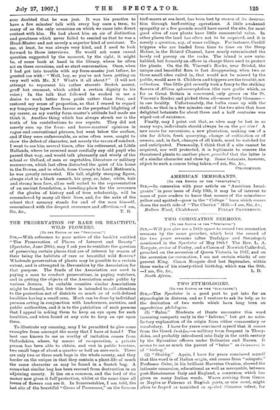THE PRESERVATION OF RARE OR BEAUTIFUL WILD FLOWERS.
[TO THE EDITOR OF THE "SPECTATOR." J
Sr,—With reference to your notice of the booklet entitled "The Preservation of Places of Interest and Beauty" (Spectator, June 29th), may I ask you to ventilate the question of preserving certain places that are of interest by reason of their being the habitats of rare or beautiful wild flowers ? Wholesale preservation of plants may be possible to a certain extent, and is attempted in Devonshire by the Association for that purpose. The funds of the Association are used in paying a man to conduct prosecutions, in paying watchers, and in getting the objects of the Association made public by various devices. In suitable counties 'similar Associations might be formed, but this letter is intended to call attention to the protection not of districts so much as of well-defined localities having a small area. Much can be done by individual persons acting in conjunction with landowners, societies, and public authorities, and it is to the patriotism of such persons that I appeal in asking them to keep an eye open for such localities, and when found at any rate to keep an eye upon
them. • To illustrate my meaning, may I be permitted to give some examples from amongst the many that I have at hand ? The best one known to me as worthy of imitation comes from Oxfordshire, where, by means of co-operation, a private person has been able to obtain, and vest in public trustees, two small bogs of about a quarter or half an acre each. There are only two or three such bogs in the whole county, and they border on the unique in that they contain a plant-life of much the same character as may be found in a Scotch bog. A somewhat similar bog has been rescued from destruction in an adjoining county. It lies on a common, and the lord of the manor now gives it full'protection, whilst at the same time all lovers of flowers can see it. In Somersetshire, I ant told, the last site of the beautiful "Grass of Parnassus," on the famous
turf-moors at sea-level, has been lost. by reason of its destruc- tion through turf-cutting operations. A little awakened sympathy or a few pounds would have saved the site, for most good sites of rare plants have little commercial value. In other places the land has often not to be acquired, and . it is merely a question, say, of some railings. For instance, Cardiff trippers who are landed front time to time on the Steep Holme, in the Bristol Channel, have nearly exterminated the lovely red paeony on the rocks. The island is now unin- ha.bited, but formerly an officer in charge there used to protect the plants. On the St. Vincent's Rocks, near Bristol, the unique and beautiful flora is fast disappearing, when two or three small sites railed in, that would not be missed by the public, would save it. Children and trippers are the trouble, not collectors. One little girl recently took a fancy to the striking flowers of Allium sphaerocephalum (the rare garlic which, as far as Great Britain is concerned, only grows on the St. Vincent's Rocks) and picked them all—some forty blossoms— in one locality. Unfortunately, the bulbs came up with the stalks, so that in a few minutes one of the two sites that have delighted botanists for about three and a half centuries was wiped out of existence.
Finally, may I point out that, as sites may be lost in so many ways, individuals should always be on the gui vive ? A new route for excursions, a. new plantation, making use of a site for dAris, fresh quarrying, change of cultivation or of owners, and, in fact, changes of all kinds, must be watched for and anticipated. Personally, I think that if a site cannot be acquired, nor well protected, it is legitimate to remove the threatened plants to another place, provided that the latter is of a similar character and close by. Some botanists, however, object to such a course being taken.—I ani, Sir, &c.,
OXONIENSIS.






































 Previous page
Previous page